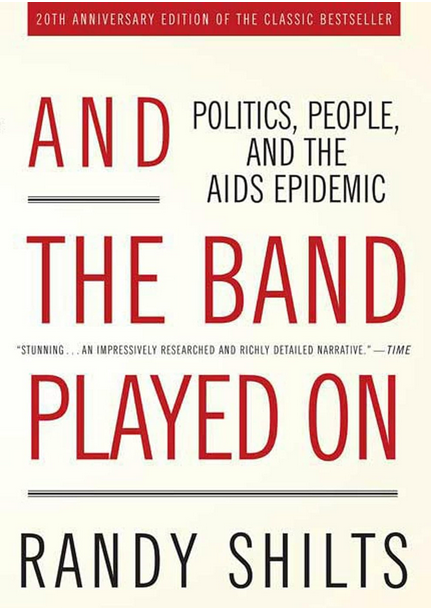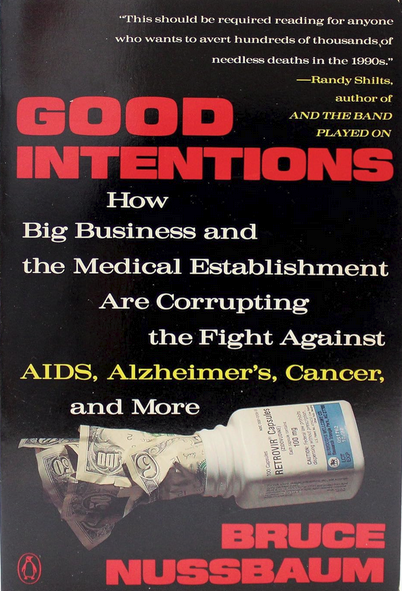This week’s FR is a twofer, but they are interconnected and the only other way to do this in a non-twofer fashion would be to post about the first book today, then the second one next time I’m up (which is June 27). Forget that. First up, at 656 pages, And the Band Played On takes some commitment, but is a relatively easy read. Author (San Francisco Chronicle reporter) Randy Shilts died from AIDS related complications (Kaposi’s sarcoma and Pneumocystis pneumonia) at the age of 42 (in 1992). This book skips between the media coverage (and non-coverage) of the epidemic, the medical community’s research and response, the political response/non-response, and individual stories of those that suffered and succumbed to the horrible disease (or had friends or family that succumbed). Shilts spends time covering the discovery of what was known in the early days as “gay cancer”, the likely proliferation and spread through bathhouses, the scientific research (many ego clashes at public health institutions), community activists, and the push/pull with government research and funding. The essential discovery by French researchers was plagiarized by American scientists, taking credit for the discoveries of the French. After reading the book, which abruptly ends without much time spent on repurposed drugs and the development of new ones, I found myself disappointed in the public health system yet again, but optimistic about the rogue frontline doctors and community activists who fought the large bureaucracies. I asked, what happened next? What about the FDA, the buyer’s clubs, and what about AZT? None of that was covered much by Shilts in depth, so I reached out and found the rest of the story in Good Intentions: How Big Business and the Medical Establishment Are Corrupting the Fight Against AIDS, by Bruce Nussbaum. I had to order it on ILL and pay the $3.50 fee. It was worth it, but every library should carry these two works for narratives about the AIDS epidemic.
Nussbaum’s work is an informative continuation of the story, but no less depressing. Many of the same actors from the work of Shilts appear, but instead of the push/pull between doctors jockeying for credit to discover things in the lab, the push/pull largely takes place between federal health agencies, pharmaceutical manufacturers, frontline doctors, and community organizations (notably ACT-Up). This clash of egos and scientific ineptitude led to many more needless deaths and suffering. One of the main villains is the NIAID, headed by Tony Fauci, who quickly proved his agency was in way over their head. NIAID took over from the National Cancer Institute (NCI), because AIDS is obviously an infectious disease, and it was hard for the NCI to argue that point. The problem was that NIAID had never been involved with drug development, and it took the agency years to figure things out. NIAID got a brief reprieve when Fauci poached more experienced oncologist Daniel Hoth from the NCI. NIAID spent copious amounts of tax dollars, placing its chips solely on AZT, like some drunk playing Big Red at the craps table. Those taking AZT in the early days (large doses) needed blood transfusions to stay alive, because it caused anemia and toxicity to bone marrow.
Community doctors became effective at treating the symptoms of AIDS, by utilizing off-label drugs, and in some cases patients cooking up their own DIY style. Many of these doctors treated specific AIDS related ailments, such as Kaposi Sarcoma (KS), a rare cancer, or PCP (pneumocystis pneumonia). The problem with some of the therapies (notably AL-721) was the fact that they often weren’t made to specifications when manufactured at home, so their efficacy was difficult to determine. And, because there was little money to be made from their sale (AL-721 is a lipid mixture extracted from egg yolks), this ensured there were no clinical trials or widespread commercial development. The FDA was often blamed for holding up the development and approval of new drugs, although there was plenty of blame to go around. At a Congressional hearing, when asked by Rep. Nanci Pelosi (representing San Francisco), what he would do if he was an AIDS patient, waiting for the Federal Bureaucracy to approve treatments, Fauci (who’s agency had been allocated over $374 million by then to develop treatments) responded:
“I probably would go with what would be available to me, be it available in the street or what have you.”
What’s largely disappointing is that the process for testing, approval, and bringing drugs to market hasn’t changed much. Nussbaum summarizes this in his Epilogue:
“In the case of the disease AIDS, and probably in cancer, heart disease, Alzheimer’s, and others, a very small number of PIs [Principal Investigators – top scientists at medical schools and hospitals who ran research trials on drugs, and were critical of anyone else doing research outside of that framework], a dozen or two, have enormous power that they misuse. … nowhere is there accountability. The NIH extramural programs, especially NIAID’s AIDS Program, may well become known as the HUD of the nineties, in which billions of taxpayer dollars have disappeared into the private projects of a handful of scientists who insist they know what is best for the health of the country. It is simply not true; they don’t.”
Shilts, Randy. And the Band Played On. St. Martin’s Griffin, Revised Ed. 2007.
Nussbaum, Bruce. Good Intentions: How Big Business and the Medical Establishment Are Corrupting the Fight Against AIDS. Atlantic Monthly Press. 1990.



